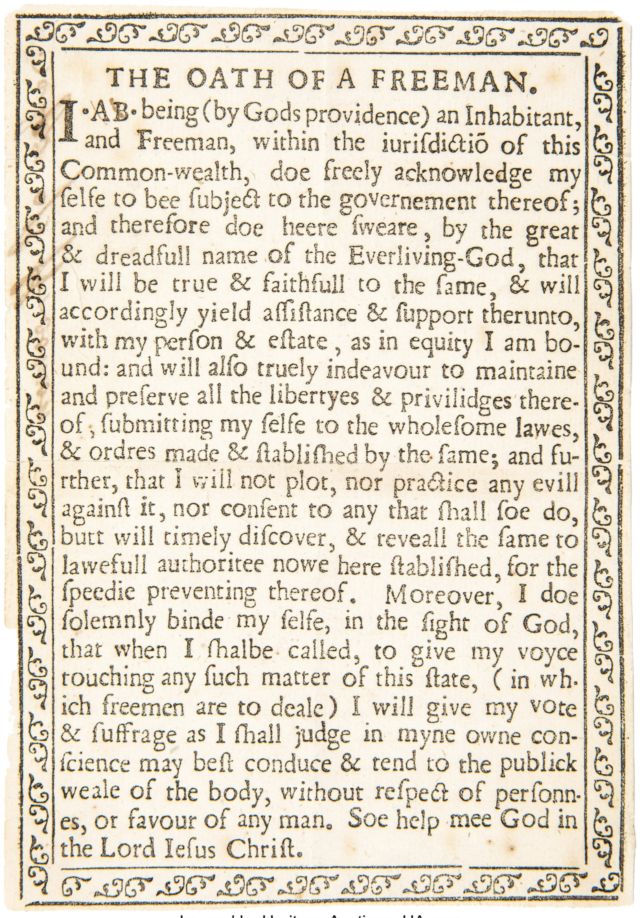The following description and image has been provided by Heritage Auctions through a recent offering. ~ Ed.
 [Mark Hofmann, forger]. The Oath of a Freeman. Printed broadside comprising a forgery of the first document printed in English North America. [The Oath of a Freeman. Cambridge, Massachusetts: Stephen Daye, circa 1638-1639 but Salt Lake City, Utah: Mark Hofmann, March 25, 1985]. Text arranged in 28 lines within an ornamental border, measuring approximately 5.875 x 4.125 inches (149 x 105 mm), with uneven edges and several tears. Docketed on verso, “Oath of a freeman” in ink in a 17th century-like hand [Mark Hofmann’s], small hole affecting “h” in “Oath” imitating iron gall ink oxidation. Housed in a polyester folder within an elaborate linen case with cover label, produced by the Library of Congress.
[Mark Hofmann, forger]. The Oath of a Freeman. Printed broadside comprising a forgery of the first document printed in English North America. [The Oath of a Freeman. Cambridge, Massachusetts: Stephen Daye, circa 1638-1639 but Salt Lake City, Utah: Mark Hofmann, March 25, 1985]. Text arranged in 28 lines within an ornamental border, measuring approximately 5.875 x 4.125 inches (149 x 105 mm), with uneven edges and several tears. Docketed on verso, “Oath of a freeman” in ink in a 17th century-like hand [Mark Hofmann’s], small hole affecting “h” in “Oath” imitating iron gall ink oxidation. Housed in a polyester folder within an elaborate linen case with cover label, produced by the Library of Congress.
The Oath of a Freeman is thought to have been printed by Stephen Daye in Cambridge, Massachusetts in 1638 or 1639. Daye was a locksmith by trade; he set up the press in America when the first printer died on the journey across the Atlantic.
As a result, “his first pieces of work were not skillfully accomplished, and wildly eccentric presswork and composition are the hallmarks of these early imprints” (Gilreath, The Judgement of Experts, page 16). The Oath of a Freeman was an important civil document in the Massachusetts Bay Colony. The taking of the Oath symbolized acceptance of the full responsibilities of citizenship in the settlement. It was the first document printed in English North America.
No copy survives.
Mark Hofmann, an erstwhile rare book and document dealer, was a client of antiquarian bookseller Justin Schiller for less than a year when he received a telephone call from him on March 14th, 1985. Earlier that day, Schiller gave Hofmann a Sotheby’s auction catalogue, Fine Printed and Manuscript Americana from the Collection of Mrs. Philip D. Sang. That catalogue included John Child’s New-Englands Jonas Cast Up at London, published in 1647, which was described as containing “the earliest reprint of ‘The Freeman’s Oath,’ the first issue of Stephen Daye’s Cambridge press, of which no copy of the original printing survives.” Hofmann explained to Schiller that he had just purchased, from Argosy Book Store in New York, a group of miscellaneous papers which included an old broadside entitled “Oath of a Freeman.” Could this be the document mentioned in the Sotheby’s catalogue?
Hofmann brought the document to New York for Schiller to examine; shortly thereafter, the two entered into a partnership wherein Hofmann gave Schiller part ownership in the document in exchange for Schiller’s representation to sell the Oath on his behalf. Schiller remembers that Hofmann did not want either himself or his source of the Oath identified. As part of their agreement, Schiller arranged for the Oath to be inspected by experts in multiple fields. Examinations by leading experts in the rare book and scientific communities were either inconclusive or concluded that the document was more likely authentic than it was forged. Examinations by the Library of Congress and the American Antiquarian Society, “both of which were conducted at the expense of the two libraries, did not definitively confirm or refute the authenticity of the printed document” (The Judgement of Experts, page 68). The examination by Walter McCrone of the McCrone Research Institute in 1987 concluded, “it may not be necessary with ‘The Oath of a Freeman‘ to do more than make qualitative observations since surely the question is 17th vs. 20th Century. On this basis I would have a high degree of confidence in accepting the 17th Century as correct in this case” (McCrone, The Judgement of Experts, page 99).
It is now known that on the evening of March 25, 1985 and into the following morning, Hofmann printed the “Oath” in his basement from a plate produced for him by the DeBouzek Engraving Company in Salt Lake City.
Mark Hofmann (born December 7th, 1954) was an accomplished forger of manuscripts and printed documents who operated during the late 1970s and early 1980s. Many of his forgeries relate to Mormon history and appear to have been intended to discredit The Church of Jesus Christ of Latter-Day Saints, the religion in which he was raised. His criminal career came to an end when he was charged with the murders of Steve Christensen and Kathleen Sheets on February 4, 1986. Almost one year later, on January 7, 1987, Hoffman pled guilty to two counts of murder and two counts of theft by deception. He is currently serving a life sentence in a Utah State Prison.
The exact nature and the total number of his forgeries are unknown.
Before Hofmann confessed to forging the present document, the “Oath” was carefully studied at both The Library of Congress and The American Antiquarian Society, with neither institution finding evidence which “would contravene a mid-seventeenth-century date.” As the only surviving copy of the first item printed in America, it had been offered for sale priced at $1,500,000.
The “Oath” is undoubtedly one of the most remarkable known forgeries ever perpetrated, and a compelling recreation of a significant document in American history. It also represents one of the most incredible and unsettling episodes in the history of the American rare book trade.

